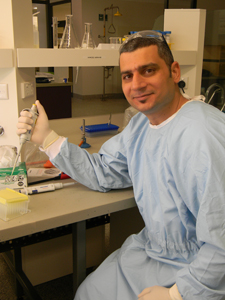 A research project that has spanned eleven years, and across four regional cities, is giving hope to diabetes sufferers internationally.
A research project that has spanned eleven years, and across four regional cities, is giving hope to diabetes sufferers internationally. Charles Sturt University (CSU) academics are working with the support of general practitioners to learn more about the indicators of diabetic complications and the results are looking positive.
With information continually gathered from more than 400 participants, chief researcher and lecturer in CSU’s School of Community Health Dr Hayder Al-Aubaidy is excited to give a better quality of life to sufferers.
“The research conducted at Charles Sturt University has identified factors that play major roles in diabetes complications such as heart disease, eye disease and kidney failure,” Dr Al-Aubaidy says. “We have used chemical biomarkers, a characteristic that indicates the presence of a physiological abnormality, to monitor our participant’s ongoing health and we can now predict complications before they happen.”
An estimated 275 Australians develop diabetes every day. The 2005 Australian AusDiab Followup Study showed that 1.7 million Australians have diabetes, but that up to half of the cases of type 2 diabetes remain undiagnosed. By 2031 it is estimated that 3.3 million Australians will have type 2 diabetes. Those with diabetes are at high risk for a number of complications.
The team of scientists at CSU has concentrated on assessing the degree of oxidative stress/antioxidants levels in people with disturbed blood glucose level (prediabetes) and in type 2 diabetes subjects, compared to the normal controls.
“By monitoring these levels we can see even a slight change that could ignite a complication,” Dr Al-Aubaidy says. “We send a report to the participant’s GP and they can discuss treatment options straight away before the problem sets in.”
Working alongside Dr Al-Aubaidy is lecturer in the School of Community Health at CSU in Orange , Dr Herbert Jelinek.and Dr Celia Barril from the School of Agriculture and Wine Sciences and Professor Lexin Wang from the School of Biomedical Sciences both at CSU in Wagga Wagga. Research within the program is also being conducted by academics in the School of Nursing, Midwifery and Indigenous Health .
“This is definitely a collaborative effort,” Professor Wang says. “As well as contributions from staff across our campuses in Albury, Bathurst, Orange and Wagga Wagga, we also have a strong relationship with the general practitioners of each research participant.”
The aim of the research is to use a series of chemical biomarkers to develop a simple, accurate, easy indicator to measure the severity of oxidative stress and assess the prognosis of prediabetes progressing to diabetes and predict development of diabetic complications.
“I will be regularly travelling to Charles Sturt University in Bathurst to use specialised equipment made available thanks to the school of Human Movement," Dr Al-Aubaidy says,"but my aim is to start a dedicated diabetes research centre in Orange and apply for funding to purchase an ELISA Reader instrument and all the other equipment necessary to measure these markers & hormones in participant samples.”





Social
Explore the world of social